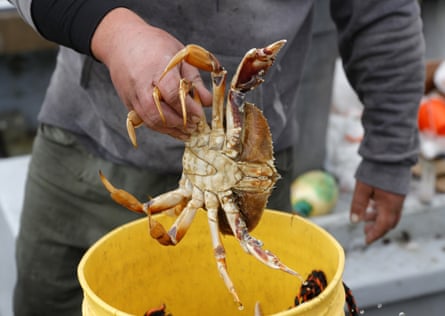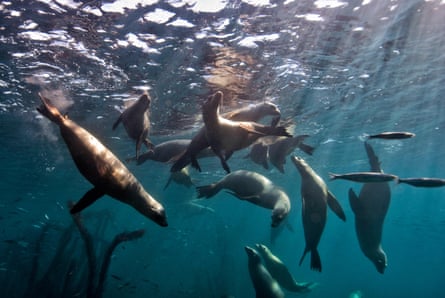The concerned calls began in mid-August. Sea lions – mostly adult females – were turning up along the southern California coast with signs of poisoning: disoriented and agitated, with their heads bobbing and their mouths foaming.
Marine animal organizations say they were inundated with inquiries from alarmed beachgoers. “We are responding to 50-100 calls a day,” the Channel Islands Marine and Wildlife Institute, which works in the island region off the coast of Los Angeles, wrote on Instagram.
The cause was quickly determined to be domoic acid poisoning – a naturally occurring neurotoxin that’s produced by a tiny single-celled marine algae. The neurotoxin accumulates in crustaceans, small fish and squid, and then gets transferred to larger predators, such as the sea lions.
While most animals usually recover within a few days from the worst symptoms after passing the acid through their urine, the Channel Islands institute said, more than 60 sea lions have been stranded in recent weeks. One died after suffering a seizure on a crowded beach near the Ventura pier.
Scientists are now working to figure out exactly what happened and what made this particular algal bloom so severe. They’re also exploring how warming oceans are altering how domoic acid, found abundantly along the California coast, is behaving.
Clarissa Anderson, a scientist who directs the Southern California Coastal Ocean Observing System, was among those receiving messages about sick sea lions. She immediately checked observation stations that take weekly sampling at piers up and down California’s coastline.

None of the samples from close to shore were showing any blooms, she says, indicating the event seemed to be taking place in the deeper waters near the Channel Islands, where most of the sick sea lions were turning up.
Blooms of the algae that creates the neurotoxin are a natural seasonal occurrence in California, Anderson says, but having one so late in the summer is unusual. “We expect that more to peak in April or May,” Anderson says, because the organism is highly responsive to coastal upwelling – when high winds cause deep waters to rise to the surface, bringing up nutrients that the algae needs to thrive – which typically happens in the spring.
Southern California is emerging as a hotspot for domoic acid: the world’s highest measurement of the neurotoxin in water occurred near San Pedro, in southern LA county, in March 2011. It was 52.3 micrograms per liter – about five times higher than a level of concern.
The acid can be passed from animals to humans who eat toxic seafood – within 30 minutes to 24 hours after eating, people may experience vomiting, diarrhea, abdominal cramps, headache and dizziness. Crustaceans, fish and shellfish can all have high levels of domoic acid in them without showing symptoms, according to the California department of public health. Also known as red tide, the threat of the toxin has previously closed down razor clam and crab fishing seasons from Monterey Bay to Alaska, costing the fishing industry millions in lost earnings.
Vera Trainer, a scientist with the Noaa north-west fisheries science center, says that scientists studying the big blooms in the Pacific north-west have found how resilient the organism is. “They are able to withstand very intense and stressful environments,” she says, falling as marine snow to the bottom of the ocean and waiting in a hibernation-like state for the right nutrients to bounce back and return to the surface.

That could mean domoic acid adapts well as ocean waters heat up. “We have evidence that these cells do well when the water is warm, and we have evidence they do well in nutrient-depleted environments that are followed by rapid nutrient inputs,” says Trainer. “And that’s likely to happen more and more as the climate changes.”
Blooms like this one are probably more likely in a future ocean that is warmer – but the science is complex because the algae species actually does better in colder waters, Anderson says, making it tough to predict exactly how it will behave. “Temperature is just one of many factors that stimulates these blooms,” she says. “They need nutrients in a certain combination to turn on the toxin.”
Researchers are also trying to understand if new strains of the algae might be evolving to thrive under higher temperatures. Anderson says some strains are moving further north – into places that were previously too cold for them. One thing is clear, though, she says: “Over the last 20 years, they have become more prevalent and more toxic.”
Anderson says she’s still trying to investigate and find out what happened to kick off the bloom. Most of the affected sea lions will recover, but repeated exposure to the toxin can have more serious and longer-lasting effects – and sea lions are especially at risk because they eat so many sardines and anchovies, which accumulate the toxin in their bodies.
Staff from the Channel Islands Institute are continuing to treat sick and stranded sea lions, they say, but worry about what lies ahead. “It truly is a crisis in Ventura and Santa Barbara counties for these sentinel species.”
